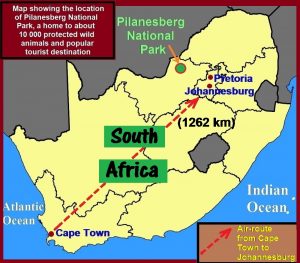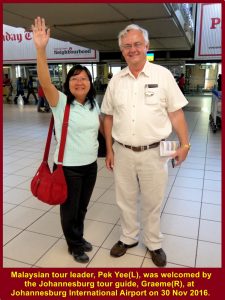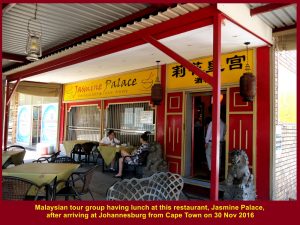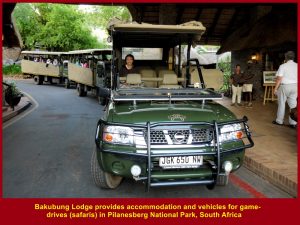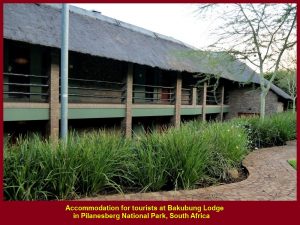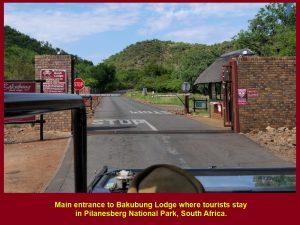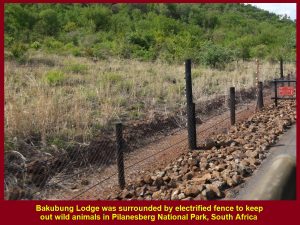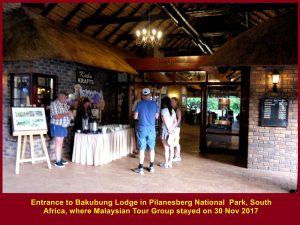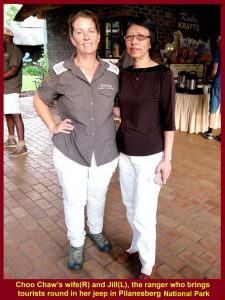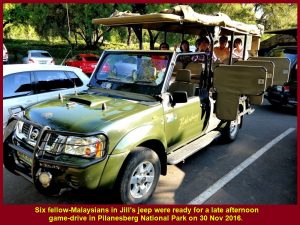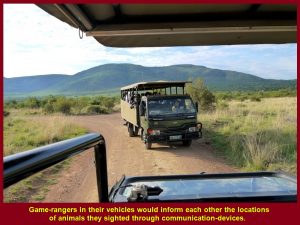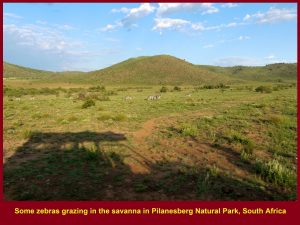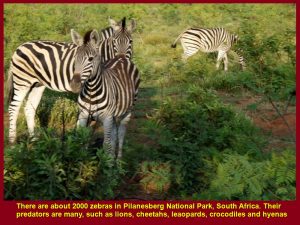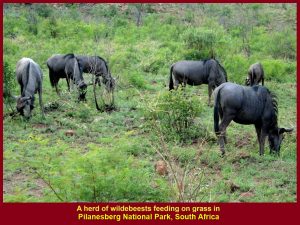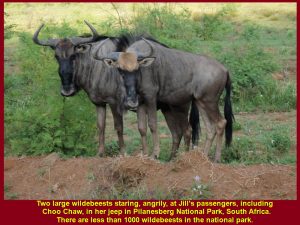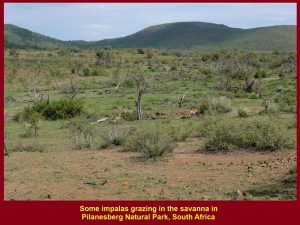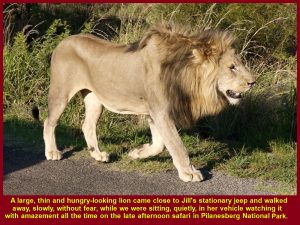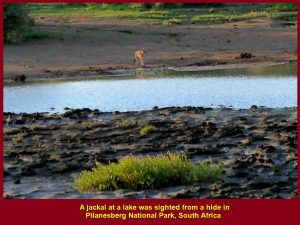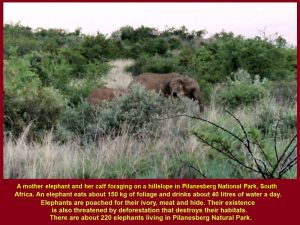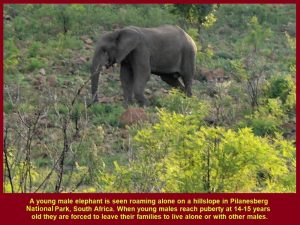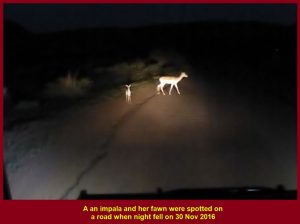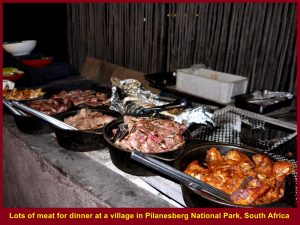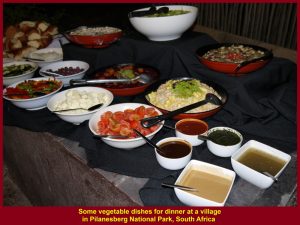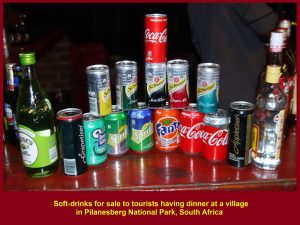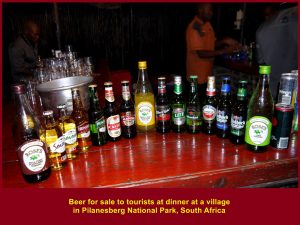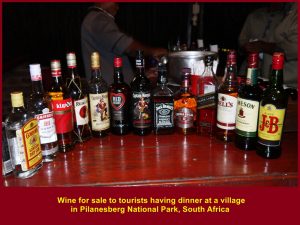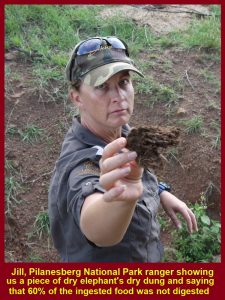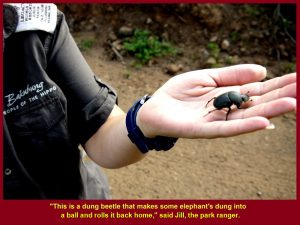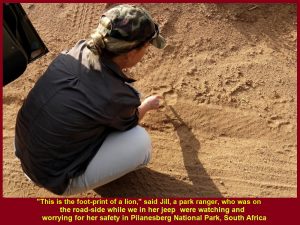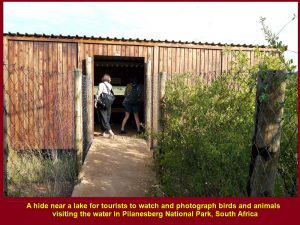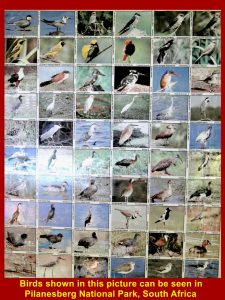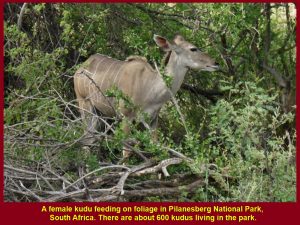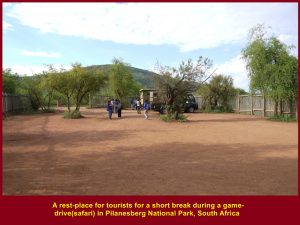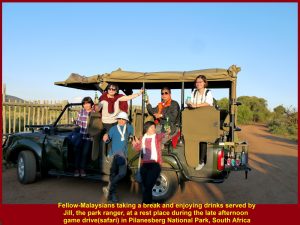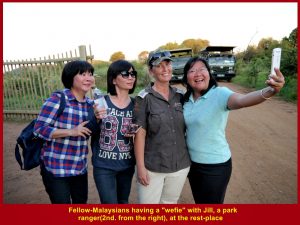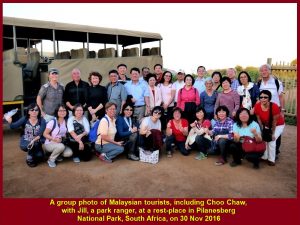South Africa Travel Part V: Cape Town to Johannesburg, Pilanesberg National Park(Game Drives)
Filed under: Pilanesberg National Park(Game Drives), South Africa Travel Part V: Cape Town to Johannesburg
South Africa Travel Part V: Cape Town to Johannesburg, Pilanesberg National Park(Game Drives)
(continue from South Africa Travel Part IV)
Day 5 Wednesday, 30 November 2016
Departure for Johannesburg from Cape Town
For the past few days we had visited many places in Cape Town City, east of the city and Cape Peninsula. Our next tour would be visiting interesting places in northern part of South Africa.
Early in the morning of 30 Nov 2016, we left the hotel, Southern Sun Hotel in the city, and went to Cape Town International Airport. From the airport, we would fly to Johannesburg, 1262 km in the north-east, for another tour in the north of South Africa.
Farewell to Cape Town Tour Guide, Cindy
Before we flew off to Johannesburg we thanked and said farewell to our Cape Town tour guide, Cindy.
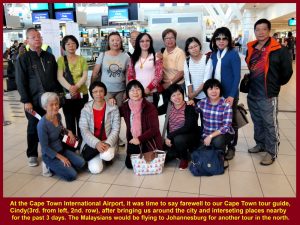
Some fellow-Malaysians taking a farewell photo with Cindy(3rd. person from the left in 2nd. row), the Cape Town tour guide, at Cape Town International Airport
Johannesburg Tour Guide, Graeme
At 9.30 a.m. our plane, a British Airways, finally departed Cape Town Two hours later, we landed at Johannesburg International Airport and were welcomed by a local tour guide, Graeme.
Lunch at Jasmine Palace, Pretoria
Then his coach drove us northwards to Pretoria, a distance of 54 km. On arrival at Pretoria at 1 p.m., we had lunch at a Chinese restaurant, Jasmine Palace.
Pilanesberg National Park
After lunch we continued our journey to a well-known national park, Pilanesberg National Park, which was 160 km north-west of Pretoria. It was that place that we would want to watch wild animals, especially the “Big 5”, and birds.
Pilanesberg Natural Park in a Crater
This park is in a crater of an extinct, large volcano surrounded by rings of hills that are formed from solidified magma exposed by weathering and erosion. The last time the volcano erupted was 1.2 billion years ago.
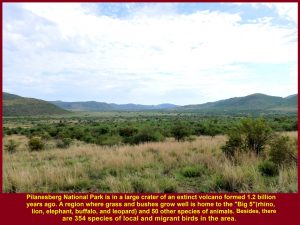
Pilanesberg National Park is in a crater of a large volcano that is extinct since 1.2 billion years ago. A home to 50 species of wild animals and 354 species of both migrant and non-migrant birds.
Now, the park is an area of about 570 sq. km of diverse vegetation and home to over 10 000 protected wild animals of 50 species and 354 species of migrant and non-migrant birds.
Bakubung Lodge, Pilanesberg National Park
The park has a few lodges and camps for tourists to stay and offer game-drives(safaris). In a game-drive, they use their vehicles to bring tourists to the park to see wild animals, including the “Big 5” of lion, elephant, leopard, rhino and buffalo. Bakubung Lodge is one of them where we stayed overnight. It is surrounded by an electrified fence to keep out wild animals.
Late Afternoon Game-Drive(Safari)
At 4 p.m on the first day of our arrival in Pilanesberg National Park, 30 Nov 2016, we checked in at Bakubung Lodge and half an hour later, we began our late afternoon game-drive(safari) in the park.
Jill, a Game-Ranger
A game-ranger of the lodge, Jill, drove seven of us in her 4×4 jeep while the other 21 fellow-Malaysians were driven by another game ranger in a large truck.
As the game rangers drove their vehicles on dirt roads in the park they informed each other the places where animals were sighted through communication devices.
Animals in the Park
The first kind of animals we saw were some zebras grazing on a grassland. As Jill was driving further we felt excited seeing other kinds of wild animals, namely wildebeests, impalas, lions, rhinos and elephants.
Zebras
There are about 1700 zebras in Pilanesberg National Park in South Africa. Their enemies are lions, crocodiles, cheetahs, leopards and hyenas.
Wildebeests
There are about 500 wildebeests in the park and are hunted by lions, cheetahs, leopards and hyenas.
Impalas
Impalas form the largest group of mammals in the park. Its total is about 3000. Like zebras and wildebeests they have the same predators.
Lions
Lions are difficult to be spotted as there are about 50 of them in the park. We were lucky to watch one that came close to our jeep without fear and then walked away to the bushes on a sunny day, 30 Nov 2016.
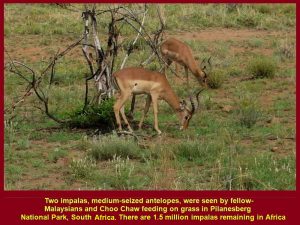
Now 1.5 million impalas remain in Africa
Jackal
A jackal was sighted at a small lake or water-hole. Its back was black. Black-backed jackals are considered the most aggressive of the jackals as it is known to attack animal prey many times its weight.
Rhinos
The number of rhinos is decreasing, annually. Poachers kill them for their horns which are sold in East Asian countries, like China and Vietnam. The people in these countries believe that the horns can treat many ailments, like cancer, rheumatism, gout, fever, typhoid and other diseases.
According to U.S. Fish and Wildlife Service, “rhino horn is made up primarily of keratin – a protein found in hair, fingernails and animal hooves”.
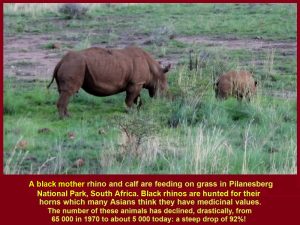
Mother rhino and calf eating grass
Elephants
About 220 elephants live in the park. These are the largest mammals in the park. An adult eats about 150 kg of foliage and drinks 40 litres of water a day. Poachers kill them for their ivory-tusks.
Young male elephants are forced to leave their families and live alone or together with other young ones when they reach puberty at the age of 14-15 years old.
Night-Time
When night fell, Jill tried to look for more animals with her spot-lamp. Several minutes later, she spotted a few impalas crossing the road we were travelling.
Animals seen in Late Afternoon Game-Drive
At about 8 p.m. Jill ended the late afternoon game-drive. Then I recalled the animals that we had spotted in the late afternoon. They were zebras, wildebeests, impalas, a lion, a jackal, rhinos and elephants. But we had not seen leopards and buffaloes belonging to the “Big 5” yet. We hoped to see them the following day.
Lots of Food for Dinner
After the late afternoon game-drive we went to a village to have dinner of native food. There was a lot of “free” food to eat, but we had to pay for drinks, like soft-drinks, beer and wine.
Lots of Drinks for Sale
Diners were spoilt for choice as there were so many kinds of drinks, but they had to pay for any drinks they chose.
Dancing and Singing
While we were having the meal young native boys and girls danced and sang for us. Earlier, those children welcomed us for dinner. After dinner we were driven back to the lodge where we stayed overnight.
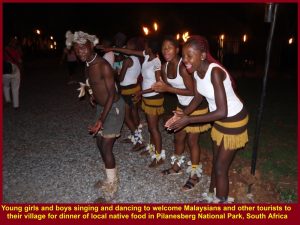
Young native boys and girls dancing and singing to welcome tourists for dinner.
and entertaining them at the meal
Day 6 Thursday, 1 Dec 2016
Morning Game-Drive
On the early following morning, Jill brought us to another part of the park for the morning game-drive(safari). In that part of the park, she told us the types of plants eaten by animals and some, like camomile flowers, were used as insect-repellents by animals.
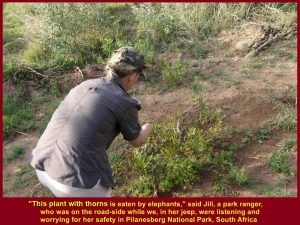
Jill told the Malaysians about the plant with thorns that was eaten by elephants
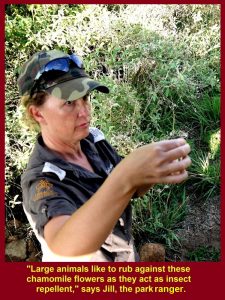
Jill said that those camomile flowers could be an insect-repellent for animals that rubbed against them
Elephants’ Digestion
Elephants are herbivores. They eat a lot of plants every day as 40% of the food is digested and their dung still contains 60% undigested food. Jill showed us a beetle that loved elephant-dung. She said that it would make the dung into a small ball and rolled it backward to its nest.
Foot-Prints of Animals
Besides, Jill showed us some foot-prints on road-sides and told us the animals that had those foot-prints. Every time Jill stepped out of her jeep to show us plants or foot-prints, we, Malaysians tourists sitting in her vehicle, were worried for her safety in Pilanesberg National Park where wild animals were lurking.
Hide
Jill brought us to a hide to watch a few kinds of water-birds, e.g. herons, egrets, eagles, cormorants and kingfishers at a water-hole, and large lake where hippos lived and other animals quenched their thirst.
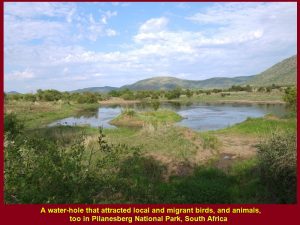
A water-hole that attracted local and migrant birds, and animals, too
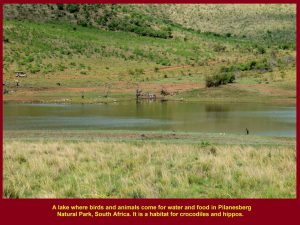
This large lake attracted many birds and animals that went for a drink. Two hippos were spotted in the water.
In the morning game-drive we saw the same animals on the previous day and three more kinds, i.e. giraffes, kudus and sable antelope.
Giraffes
Two young giraffes were seen by us eating leaves on the trees on a hillslope on the morning of 1 Dec 2016.. An adult eats about 34 kg of foliage a day. The number of these mammals that remain in Africa is about 98000 but about 170 live in Pilanesberg National Park.
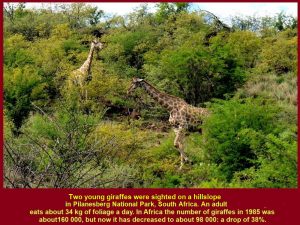
Two young giraffes eating leaves on a hillslope. About 98000 giraffes live in Africa and 170 in Pilanesberg National Park
Kudus
There are about 600 kudus living in Pilanesberg National Park. The males have long, spiral horns whereas the females have no horns.
Sable Antelope
A sable antelope was a rare sight in Pilanesberg National Park. It had two long. curved horns and could weigh as much as 250 kg.
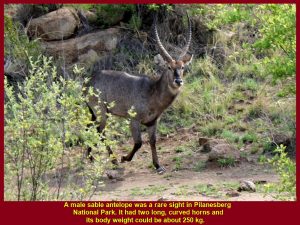
A sable antelope was a rare sight in Pilanesberg National Park. It had two long, curved horns and its body weight could be about 250 kg.
Rest-Place
Each game-drive lasted for 3-4 hours and had a short break at a rest-place where the game-rangers would offer us drinks and snacks. Then the game-drive resumed.
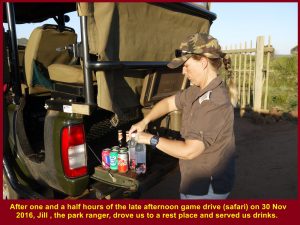
Jill. a park ranger, preparing drinks and snacks for Choo Chaw and fellow-Malaysians at a rest-place
Time for Photographing
Malaysians took an opportunity for photographing at the rest-place.
“Big 5”
When the morning game-drive ended at 8.40 a.m. we felt disappointed for not being able to spot all the five animals in the “Big 5”. We failed to see leopards and buffaloes in the two game-drives(safaris) in Pilanesberg National Park. But we were happy to have seen many kinds of animals not listed in the “Big 5”.
Departure for Sun City
At 10 a.m. we left Pilanesberg National Park for Sun City which was nearby, and then to more places.
(continue in South Africa Travel Part VI)
Written by Choo Chaw
South Africa Travel Part I: Air Flight from KLIA to Cape Town, Cape Town Shantytowns
South Africa Travel Part II: Table Mountain, Malay Quarter, Castle of Good Hope. A & V Waterfront
South Africa Travel Part III: Hermanus, Cheetah Outreach, Stellenbosch, Jewel Africa
South Africa Travel Part V: Pilanesberg National Park(Game Drives)
South Africa Travel Part VI: Sun City, Union Buildings, Vootrekker Monument
South Africa Travel Part VII Kruger Museum, Church Square, Melrose Museum, Carnivore Restaurant
South Africa Travel Final Part Gold Reef City: Gold Mine Museum

